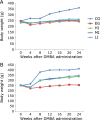Isoflavone intake inhibits the development of 7,12-dimethylbenz(a)anthracene(DMBA)-induced mammary tumors in normal and ovariectomized rats
- PMID: 24426188
- PMCID: PMC3882481
- DOI: 10.3164/jcbn.13-33
Isoflavone intake inhibits the development of 7,12-dimethylbenz(a)anthracene(DMBA)-induced mammary tumors in normal and ovariectomized rats
Abstract
To determine the associations between isoflavone (49.72% genistin, 5.32% daidzin, 34.54% glycitin) and breast cancer risk, 150 rats were given 5 mg 7,12-dimethylbenz(a)anthracene and half of them were ovariectomized. Then normal rats and ovariectomized rats were divided into 5 groups: control group, isoflavone high (HI), middle (MI), or low (LI) dose group consuming 100, 500, or 1000 mg isoflavones/kg diet, estrogen group (2.5 mg stilboestrol/kg diet). After 24 weeks, tumor incidences were 73% in control group, 7% in HI, 7% in MI, 27% in LI, and 80% in estrogen group for normal rats; 60% in control group, 13% in HI, 7% in MI, 13% in LI, and 73% in estrogen group for ovariectomized rats. Isoflavone treatment decreased tumor incidence and mean tumor number per rat and increased mean latent period compared with those in control group and estrogen group group significantly (p<0.05). The mRNA and protein expression of estrogen receptor β were significantly higher in isoflavone treatment groups than those in control group group. Moreover, isoflavone treatment significantly decreased 8-hydroxydeoxyguanosine content and increased superoxide dismutase level in normal rats and decreased malondialdehyde concentrations in ovariectomized rats compared with control group. In conclusions, isoflavone intake significantly inhibited the development of premenopausal and postmenopausal mammary tumors.
Keywords: estrogen receptor; isoflavones; mammary tumors; ovariectomized rats.
Figures





Similar articles
-
[Effect of soy isoflavones on the incidence of 7, 12-dimethylbenz (alpha) anthracene-induced breast tumors in rats].Beijing Da Xue Xue Bao Yi Xue Ban. 2010 Jun 18;42(3):288-92. Beijing Da Xue Xue Bao Yi Xue Ban. 2010. PMID: 20559403 Chinese.
-
Dietary effects of soy isoflavones daidzein and genistein on 7,12-dimethylbenz[a]anthracene-induced mammary mutagenesis and carcinogenesis in ovariectomized Big Blue transgenic rats.Carcinogenesis. 2006 Oct;27(10):1970-9. doi: 10.1093/carcin/bgl028. Epub 2006 May 18. Carcinogenesis. 2006. Corrected and republished in: Carcinogenesis. 2006 Dec;27(12):2555-64. doi: 10.1093/carcin/bgl195. PMID: 16709578 Corrected and republished.
-
Dietary effects of soy isoflavones daidzein and genistein on 7,12-dimethylbenz[a]anthracene-induced mammary mutagenesis and carcinogenesis in ovariectomized Big Blue transgenic rats.Carcinogenesis. 2006 Dec;27(12):2555-64. doi: 10.1093/carcin/bgl195. Carcinogenesis. 2006. PMID: 17127718
-
Comparative study on reduction of bone loss and lipid metabolism abnormality in ovariectomized rats by soy isoflavones, daidzin, genistin, and glycitin.Biol Pharm Bull. 2001 Apr;24(4):368-72. doi: 10.1248/bpb.24.368. Biol Pharm Bull. 2001. PMID: 11305597
-
Obesity increases the incidence of 7,12-dimethylbenz(a)anthracene-induced mammary tumors in an ovariectomized Zucker rat model.Int J Oncol. 2007 Mar;30(3):557-63. Int J Oncol. 2007. PMID: 17273756
Cited by
-
Allyl isothiocyanate regulates oxidative stress, inflammation, cell proliferation, cell cycle arrest, apoptosis, angiogenesis, invasion and metastasis via interaction with multiple cell signaling pathways.Histochem Cell Biol. 2024 Mar;161(3):211-221. doi: 10.1007/s00418-023-02255-9. Epub 2023 Nov 29. Histochem Cell Biol. 2024. PMID: 38019291 Review.
-
Isoflavones in Soybean as a Daily Nutrient: The Mechanisms of Action and How They Alter the Pharmacokinetics of Drugs.Turk J Pharm Sci. 2021 Dec 31;18(6):799-810. doi: 10.4274/tjps.galenos.2020.79106. Turk J Pharm Sci. 2021. PMID: 34979737 Free PMC article.
-
[Equol and its enantiomers inhibited urethane-induced lung cancer in mice].Beijing Da Xue Xue Bao Yi Xue Ban. 2022 Apr 18;54(2):244-248. doi: 10.19723/j.issn.1671-167X.2022.02.007. Beijing Da Xue Xue Bao Yi Xue Ban. 2022. PMID: 35435186 Free PMC article. Chinese.
-
Understanding the Composition, Biosynthesis, Accumulation and Transport of Flavonoids in Crops for the Promotion of Crops as Healthy Sources of Flavonoids for Human Consumption.Nutrients. 2020 Jun 8;12(6):1717. doi: 10.3390/nu12061717. Nutrients. 2020. PMID: 32521660 Free PMC article. Review.
-
Current Perspectives on the Beneficial Effects of Soybean Isoflavones and Their Metabolites for Humans.Antioxidants (Basel). 2021 Jun 30;10(7):1064. doi: 10.3390/antiox10071064. Antioxidants (Basel). 2021. PMID: 34209224 Free PMC article. Review.
References
-
- Wu AH, Ziegler RG, Nomura AM, et al. Soy intake and risk of breast cancer in Asians and Asian Americans. Am J Clin Nutr. 1998;68:1437S–1443S. - PubMed
-
- Ganry O. Phytoestrogen and breast cancer prevention. Eur J Cancer Prev. 2002;11:519–522. - PubMed
-
- Rice MM, LaCroix AZ, Lampe JW, et al. Dietary soy isoflavone intake in older Japanese American women. Public Health Nutr. 2001;4:943–952. - PubMed
-
- Shu XO, Jin F, Dai Q, et al. Soyfood intake during adolescence and subsequent risk of breast cancer among Chinese women. Cancer Epidemiol Biomarkers Prev. 2001;10:483–488. - PubMed
LinkOut - more resources
Full Text Sources
Other Literature Sources

